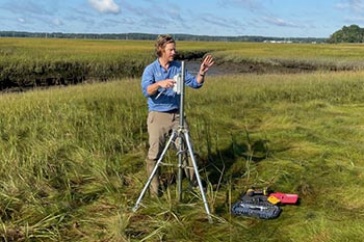UNH Receives Over $3 Million For Multi-State Coastal Restoration and Resilience Program

Gregg Moore, associate professor of biological sciences at the University of New Hampshire, sets up wireless water level recorders in the Hampton Seabrook Estuary to set a baseline for salt marsh tidal regime that will inform future resilience actions. Photo credit: Jenny Gibson / UNH
DURHAM, N.H.— Researchers at the University of New Hampshire have received $3.1 million from the National Fish and Wildlife Foundation (NFWF) for an innovative project to pair marsh restoration and resilience efforts in the Hampton-Seabrook Estuary with dune stabilization measures from northern Massachusetts to southern New Hampshire. These endeavors are aimed at protecting the Great Marsh which ecologically extends across the two states. The project will use a variety of restoration techniques coupled with the latest technology, like drone-based modelling, and will involve stakeholders, community volunteers and K-12 students to participate in creating solutions to stabilize and manage these fragile ecosystems.
“The Great Marsh is a dynamic watershed system that serves as the primary coastal resilience landform protecting homes, businesses, infrastructure and the invaluable resources of the estuary,” said Gregg Moore, associate professor of biological sciences and principal investigator. “Great Marsh exists because of the fragile dunes and now these coastal habitats are in peril from threats like sea-level rise, coastal storms and other pressures, and we feel management plans shouldn’t stop at state borders.”
The researchers, and their partners, have been developing approaches to help bolster the resilience of the broader Great Marsh for over 15 years. This project will build on that experience by reaching across state borders to develop a mutual cooperation to stabilize 10 miles of dunes and benefit over 1,000 acres of salt marsh through restoration actions that help maintain vital habitat for threatened species, including piping plover and salt marsh sparrow. In addition, they will initiate a pilot sediment placement project in the nearby Great Bay Estuary to gauge if it can make a difference in rescuing areas of the marsh designated as “drowning” - when marsh growth is outpaced by sea level rise. Along with these three restoration and resilience approaches, researchers plan to also incorporate an engaged scholarship component, recruit over 750 volunteers including students, teachers, community members and project partners, as well as creating a dune and marsh monitoring network for affected communities, stakeholders and resource users to guide adaptation activities for present and future climate scenarios.
The Great Marsh is the longest, continuous saltmarsh estuary in New England extending from Cape Ann in MA northward to Hampton, NH. It includes over 20,000 acres consisting of a network of tidal rivers, tributaries and coastal wetlands formed behind the dune and sandy barrier beach system that protects it to this day. Its vast landscape provides a vital habitat for threatened plants and animals and serves as an important protectant.
David Burdick, research associate professor, and Alyson Eberhardt, extension specialist at UNH Cooperative Extension and NH Sea Grant, will serve as co-principal investigators.
State and community partners will include the NH Department of Environmental Services, Climate Adaptation Workgroup, Seabrook-Hampton Estuary Alliance, Hampton-Seabrook Collaboration, Piscataqua Region Estuary Partnership, National Wildlife Federation, Merrimack Valley Planning Commission, Merrimack River Beach Alliance, Plum Island Taxpayers Association, Massachusetts Department of Conservation and Recreation, and Conservation Commissions in the coastal municipalities of Newbury, Newburyport, Salisbury, Seabrook, Hampton, Essex and Ipswich.
The University of New Hampshire inspires innovation and transforms lives in our state, nation and world. More than 16,000 students from all 50 states and 71 countries engage with an award-winning faculty in top-ranked programs in business, engineering, law, health and human services, liberal arts and the sciences across more than 200 programs of study. A Carnegie Classification R1 institution, UNH partners with NASA, NOAA, NSF and NIH, and received $260 million in competitive external funding in FY21 to further explore and define the frontiers of land, sea and space.
PHOTOS FOR DOWNLOAD
https://www.unh.edu/unhtoday/sites/default/files/media/dunes_moore.jpeg
Gregg Moore, associate professor of biological sciences at the University of New Hampshire, sets up wireless water level recorders in the Hampton Seabrook Estuary to set a baseline for salt marsh tidal regime that will inform future resilience actions.
Photo credit: Jenny Gibson / UNH
https://www.unh.edu/unhtoday/sites/default/files/media/dune_restoration_rebuilding_sign.jpeg
A newly planted patch of native beach grass, that will help create a natural barrier, is one of the traditional methods used by scientists to benefit the broader ecological environment.
Photo Credit: Tim Briggs / NH Sea Grant
https://www.unh.edu/unhtoday/sites/default/files/media/dune_restoration_high_schoolers_planting_wider.jpeg
Scientists and volunteers work along a stretch of sand dunes to plant native plants that can help vital habitats in the dunes of the Great Marsh.
Photo Credit: Tim Briggs / NH Sea Grant
Latest News
-
November 26, 2025
-
November 6, 2025
-
November 5, 2025
-
October 24, 2025
-
October 8, 2025














































